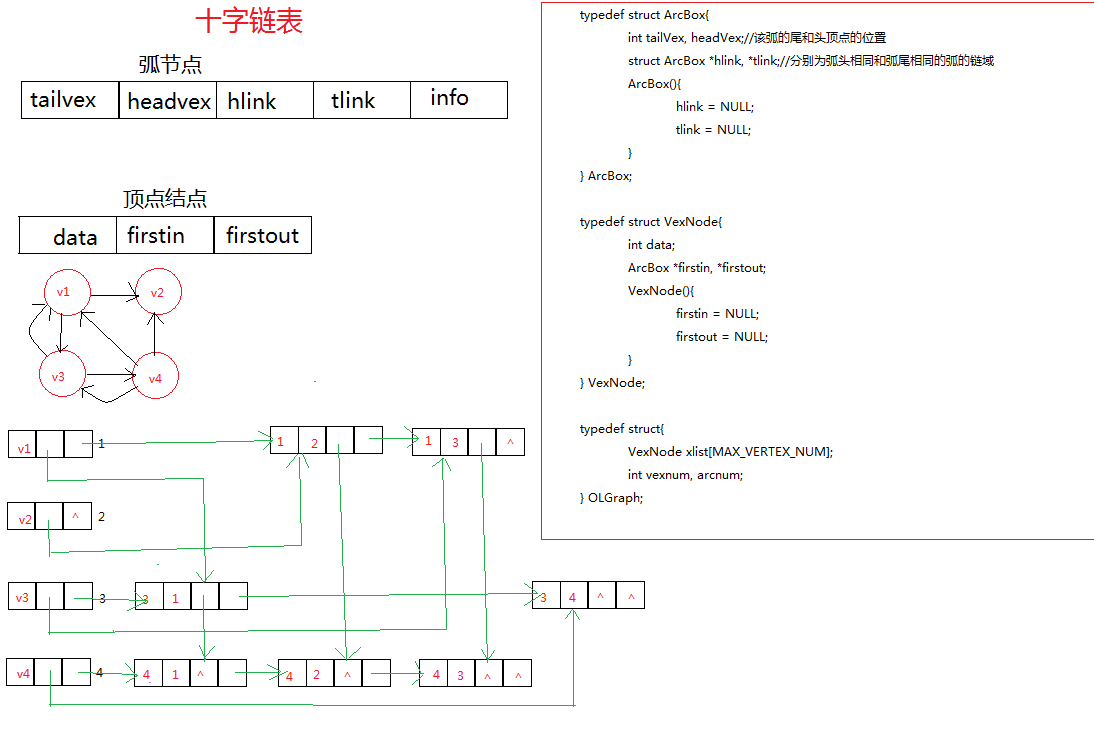十字链表的应用

#include<iostream> #include<cstring> #include<cstdio> #include<cstdlib> #define MAX_VERTEX_NUM 20 using namespace std; typedef struct ArcBox{ int tailVex, headVex;//该弧的尾和头顶点的位置 struct ArcBox *hlink, *tlink;//分别为弧头相同和弧尾相同的弧的链域 ArcBox(){ hlink = NULL; tlink = NULL; } } ArcBox; typedef struct VexNode{ int data; ArcBox *firstin, *firstout; VexNode(){ firstin = NULL; firstout = NULL; } } VexNode; typedef struct{ VexNode xlist[MAX_VERTEX_NUM]; int vexnum, arcnum; } OLGraph; void buildG(OLGraph &g, int u, int v){ ArcBox *p = new ArcBox; /* 或者, new 方式可以调用类的构造函数 ArcBox *p = (ArcBox *)malloc(sizeof(ArcBox)); p->hlink = NULL; p->tlink = NULL; */ p->tailVex = u; p->headVex = v; if(g.xlist[u].firstout == NULL){//在弧尾的地方插入 g.xlist[u].firstout = p; } else { ArcBox *tmp = g.xlist[u].firstout; while(tmp->tlink) tmp = tmp->tlink;//找到和u节点相关的最后一个弧尾 tmp->tlink = p; } if(g.xlist[v].firstin == NULL){//在弧头的地方插入 g.xlist[v].firstin = p; } else { ArcBox *tmp = g.xlist[v].firstin; while(tmp->hlink) tmp = tmp->hlink;//找到和u节点相关的最后一个弧头 tmp->hlink = p; } } void inG(OLGraph g){ printf("从每一个节点出度方向遍历弧\n"); for(int i=1; i<=g.vexnum; ++i){ ArcBox *tmp = g.xlist[i].firstout;//找到弧尾节点为i的第一个节点 printf("节点 %d:\n"); while(tmp) { printf("弧 %d %d\n", tmp->tailVex, tmp->headVex); tmp = tmp->tlink; } } } void outG(OLGraph g){ printf("每一个节点的入度方向遍历弧\n"); for(int i=1; i<=g.vexnum; ++i){ ArcBox *tmp = g.xlist[i].firstin;//找到弧头节点为i的第一个节点 printf("节点 %d:\n"); while(tmp) { printf("弧 %d %d\n", tmp->tailVex, tmp->headVex); tmp = tmp->hlink; } } } int main(){ printf("请输入图的节点的个数和图的弧数:\n"); OLGraph g; scanf("%d %d", &g.vexnum, &g.arcnum); printf("请输入图的弧:\n"); for(int i=0; i<g.arcnum; ++i) { int u, v; scanf("%d %d", &u, &v); buildG(g, u, v); } //遍历方式,1.从每一个节点出度方向遍历弧 2.从每一个节点的入度方向遍历弧 inG(g); printf("*****************\n"); outG(g); return 0; } /* 有向图测试数据: 4 7 1 2 4 2 4 1 1 3 3 1 3 4 4 3 */
本文来自博客园,作者:hjzqyx,转载请注明原文链接:https://www.cnblogs.com/hujunzheng/p/4649360.html



